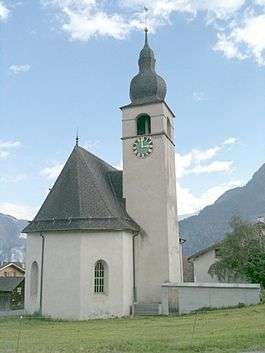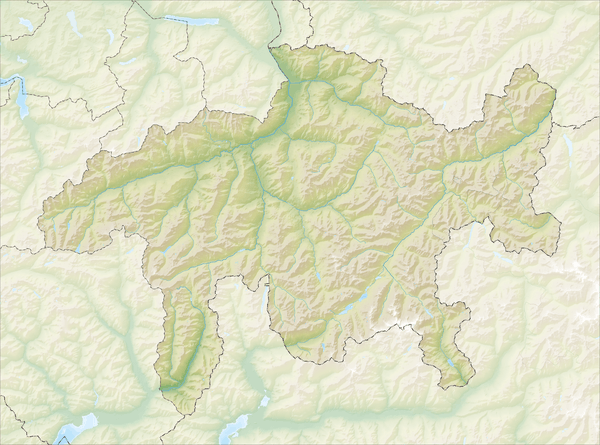Urmein
Urmein (Romansh: Urmagn) is a municipality in the Viamala Region in the Swiss canton of Graubünden.
Urmein | |
|---|---|
 | |
 Coat of arms | |
Location of Urmein 
| |
 Urmein  Urmein | |
| Coordinates: 46°41′N 9°26′E | |
| Country | Switzerland |
| Canton | Graubünden |
| District | Viamala |
| Area | |
| • Total | 4.33 km2 (1.67 sq mi) |
| Elevation | 1,264 m (4,147 ft) |
| Population (2018-12-31)[2] | |
| • Total | 154 |
| • Density | 36/km2 (92/sq mi) |
| Postal code | 7427 |
| SFOS number | 3670 |
| Surrounded by | Flerden, Lohn, Masein, Thusis, Tschappina |
| Website | website missing SFSO statistics |
History
Urmein is first mentioned in 1156 as Hof de Ormen.[3]
Geography
Urmein has an area, as of 2006, of 4.4 km2 (1.7 sq mi). Of this area, 46.9% is used for agricultural purposes, while 39.5% is forested. Of the rest of the land, 5.7% is settled (buildings or roads) and the remainder (7.8%) is non-productive (rivers, glaciers or mountains).[4]
Before 2017, the municipality was located in the Thusis sub-district, of the Hinterrhein district, after 2017 it was part of the Viamala Region.[5] It consists of the haufendorf (an irregular, unplanned and quite closely packed village, built around a central square) village of Urmein in the inner Heinzenberg mountains at an elevation of 1,264 m (4,147 ft).
Demographics
Urmein has a population (as of 31 December 2018) of 154.[6] As of 2008, 3.7% of the population was made up of foreign nationals. Over the last 10 years the population has grown at a rate of 19.8%.[4]
As of 2000, the gender distribution of the population was 45.9% male and 54.1% female.[7] The age distribution, as of 2000, in Urmein is; 1 child or 1.2% of the population is between 0 and 9 years old. 2 children or 2.5% are 10 to 14, and 3 children or 3.7% are 15 to 19. Of the adult population, 14 people or 17.3% of the population are between 20 and 29 years old. 6 people or 7.4% are 30 to 39, 9 people or 11.1% are 40 to 49, and 18 people or 22.2% are 50 to 59. The senior population distribution is 14 people or 17.3% of the population are between 60 and 69 years old, 10 people or 12.3% are 70 to 79, there are 4 people or 4.9% who are 80 to 89.[8]
In the 2007 federal election the most popular party was the SVP which received 66.9% of the vote. The next three most popular parties were the FDP (13.2%), the SPS (12.9%) and the local, small right-wing parties (4.2%).[4]
In Urmein about 72.9% of the population (between age 25-64) have completed either non-mandatory upper secondary education or additional higher education (either university or a Fachhochschule).[4]
Urmein has an unemployment rate of 0%. As of 2005, there were 28 people employed in the primary economic sector and about 11 businesses involved in this sector. No one is employed in the secondary sector. 7 people are employed in the tertiary sector, with 4 businesses in this sector.[4]
The historical population is given in the following table:[3]
| year | population |
|---|---|
| 1803 | 158 |
| 1850 | 133 |
| 1900 | 89 |
| 1950 | 90 |
| 2000 | 81 |
Languages
Most of the population (as of 2000) speaks German (98.8%), with the rest speaking Polish ( 1.2%).[4]
| Languages in Urmein | ||||||
| Languages | Census 1980 | Census 1990 | Census 2000 | |||
| Number | Percent | Number | Percent | Number | Percent | |
| German | 73 | 96.05% | 79 | 97.53% | 80 | 98.77% |
| Romanish | 2 | 2.63% | 2 | 2.47% | 0 | 0.00% |
| Population | 76 | 100% | 81 | 100% | 81 | 100% |
See also
References
- "Arealstatistik Standard - Gemeinden nach 4 Hauptbereichen". Federal Statistical Office. Retrieved 13 January 2019.
- "Ständige Wohnbevölkerung nach Staatsangehörigkeitskategorie Geschlecht und Gemeinde; Provisorische Jahresergebnisse; 2018". Federal Statistical Office. 9 April 2019. Retrieved 11 April 2019.
- Urmein in German, French and Italian in the online Historical Dictionary of Switzerland.
- Swiss Federal Statistical Office accessed 08-Oct-2009
- Swiss Federal Statistical Office - Amtliches Gemeindeverzeichnis der Schweiz - Mutationsmeldungen 2016 accessed 16 February 2017
- Swiss Federal Statistical Office - STAT-TAB, online database – Ständige und nichtständige Wohnbevölkerung nach institutionellen Gliederungen, Geburtsort und Staatsangehörigkeit (in German) accessed 23 September 2019
- Graubunden in Numbers Archived 2009-09-24 at the Wayback Machine (in German) accessed 21 September 2009
- Graubunden Population Statistics Archived 2009-08-27 at the Wayback Machine (in German) accessed 21 September 2009
| Wikimedia Commons has media related to Urmein. |